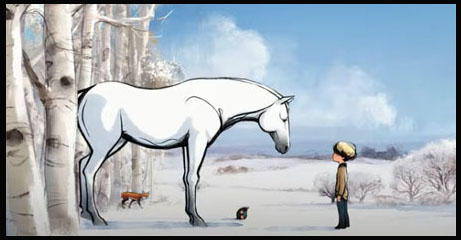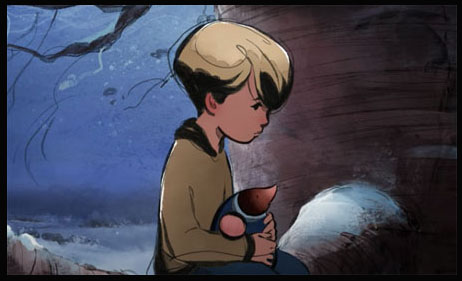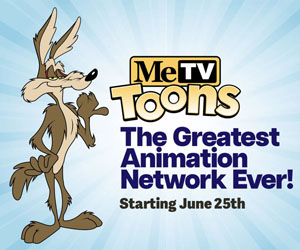
On Christmas Day, you can experience the new short film version of author Charlie Mackesy’s beloved book The Boy, The Mole, The Fox and The Horse on AppleTV+. Mackesy and Peter Baynton are the co-directors. Cara Speller serves as producer. They share what makes the deep story and gorgeous animation so special and how this film will comfort those who are struggling during the holidays. (This Animation Scoop Q&A was edited for length and clarity.)
Jackson Murphy: Charlie, what fascinated you about the book to screen transition with this story?
Charlie Mackesy: I always felt that the characters lent themselves to movement — I always wondered how they would sound and how it would feel to see them go across the page. I wondered about it so much that I did my own very, very bad, basic, rudimentary animations to see how it would feel to see them all move. In my head it was always a question, but I never dreamt it would never come to anything.

JM: What surprised you the most about when you discovered how well these characters look in this new format?
CM: It was kind of thrilling. It took a while for them to finally arrive, but when they did, I remember running around the garden screaming.
JM: (laughs)
CM: It felt good to see them come to life. I always try to make drawings look alive. To create movement in a still drawing is something I’ve always liked doing, but obviously it’s nothing compared to them actually moving. (laughs)
Cara Speller: Yeah, that was a big translation, wasn’t it? Your drawings are so full of life. You capture movement within a single frame, and what we needed to develop from there was movement over multiple frames.

CM: Yeah, but I think on many levels that’s more of a nightmare for an animator than a drawing that doesn’t look like it’s moving in a single frame. That actually creates more problems than if it would have been just very static. On that basis alone, I want to congratulate everyone involved in making the animation. It was a very difficult job to bring drawings that already had several fluid lines. I’m slightly in awe of the animators for achieving this.
JM: Cara, what were your goals with the gentle nature of this story?
CS: Everything always comes back to the book and the feeling that spending time with the book gives you. That was our touchstone throughout. Every question we had about anything came back to that. It was really important for us to allow some of that stillness and some of that space Charlie has in the book. There’s blank pages where you have the ability to think about something that the characters are discussing and let it really resonate with you. It was really important to us that we catch the truth of that in the film — that we give people that space.
JM: I love the dialogue. It’s so rich. And it makes you think. Peter, what do you love so much about the dialogue and how it makes you feel?
Peter Baynton: This whole project is kind of a dream come true. Charlie and Cara are very special people. The whole crew is wonderful and embodies so many of the messages. The dialogue, themes and messages feel so much bigger and more important than anything you can do.

Cara Speller, Charlie Mackesy and Peter Baynton
JM: I think it’s going to have a big impact on families. The animals mean so much to the boy. Charlie, what are the words that come to mind… how did you want to approach the animals towards the boy?
CM: I think they’re all part of us. The conversations have all the levity and the pathos that we have within ourselves and each other, whether it’s obsessing about cake or asking the bigger questions of why we exist. There’s a degree of honesty and transparency and vulnerability about all of them and their desires for connection, truth, hope and fear. We are melting pots of all kinds of things. Hopefully those four characters touch on all of those.
PB: And they’re kind of equals. We also talked about them as equals. That came through in how we arranged them on the screen. When the horse speaks to the fox (saying ‘being honest is always interesting’), his head was down level with the fox. He wasn’t saying it from above him. When the boy thanks the fox for rescuing the mole, we wanted to make sure that when he scoots across, he remains level with the fox at that point. There isn’t a hierarchy. They’re all equals.
JM: Cara, were there some difficulties with making sure the characters could pop alongside the snow — and making sure the snow still glistens and shines?
CS: I don’t think the snow was one of the particular production challenges. There’s lots of different types of snow. There’s snow that can be threatening to life and a terrible thing, and there’s snow that can be a very gentle, calming, cozy feeling of warmth when you’re with the people that you love. The challenge, if there was one, was we wanted to make sure the snow was a gentle, kind form of snow, rather than a dangerous thing.
PB: We called it ‘lazy snow’. The way it fell had to feel sort of lazy.

JM: And Peter, the music in this is lovely. How did you want to incorporate the music in just the right places and ways?
PB: That’s a good question. The experience of watching the film… we wanted something that felt immersive. You can just sink into this thing. The music does so much of that. Isobel Waller-Bridge, our fantastic composer, wrote with Charlie a piece of music called “The Hint of the Robin” very very early on in the production when we were still doing the storyboard. We cut it to picture in a couple places and we were weeping with how powerful it was and how well it worked. It formed the backbone of the score. And everything else were variations or responses to that music.
CS: And you [Charlie] already had a lovely relationship with Isobel before we started.
CM: That’s right. Isobel is a friend. She approached me years ago about doing something related to the book before the film was even a twinkling in our eyes. She was emotionally invested in the idea and knew the characters pretty well and confessed to having cried a lot at the book. She helped me with the audiobook with some of the sounds of the fox. So when it came to scoring the film, it seemed obvious to have her do the score. I think she would’ve done it for free. Her heart and soul were embedded in it.
CS: She was very much a part of the team and really invested in it right from the start.
JM: That’s great. J.J. Abrams is a producer. I’m always fascinated with the projects he chooses that are not in the sci-fi / fantasy wheelhouse.
CS: Hannah Minghella, who works at his company Bad Robot, had come across Charlie’s book in a bookshop in London in early 2020, I believe, and had fallen in love with it in exactly the same way as we all had. She bought 10 copies and sent them to all her friends. She was the one who actually initially contacted Charlie and his partner Matthew [Freud], independently of me. We were both coming at this from separate countries. She expressed a real love for the book and a desire to be part of turning it into the film. In terms of Bad Robot, it was really Hannah who drove that passion on their part to be involved.

JM: And Woody Harrelson too! How did Woody get involved?
CM: Woody watched a lot of the animatics and became quite obsessed with the book and the early animatics. That was his entry.
CS: He’s been a huge supporter of the film from the beginning. We’re very grateful to him.
CM: A lot of the people involved in the book and the film were drawn-in, very unofficially, for personal reasons. It’s been very much an organic collective of people with a similar heart and desire to be involved, which I find deeply moving.
JM: What does “home” mean to the three of you? That is a huge theme of this.
CS: It is what Charlie talks about in the book and hopefully what we’re talking about in the film. Home is absolutely the people you love. There’s an interesting linguistic difference between the word “house” and the word “home”. They mean two very, very different things. A house is just a building that you live in. A home is a place that you, hopefully, feel safe and secure and loved.
PB: That’s spot on.
CM: I will agree and say… that I’ve always felt restless. There’s a part of me that’s always seeking something. I never quite know what. It definitely is a desire from home. Are you at your home in your own skin? I never did feel that. The journey / doorway into that was suddenly fully accepting myself as I am — right now, right here, at being enough. That’s where home is for me: sitting in Manhattan where I don’t belong, walking down a street alone… am I at home right here right now within myself? Is that enough? And that’s a very strange journey to have made, and it’s definitely with my friends, but sometimes my friends aren’t here. I’m not married. I don’t have children. I have a wonderful family — a wonderful sister and an incredible, 93 year old mother who, when I do go back, I do feel home. But it’s yet still deeper than that. That’s a very big journey to make.
CS: I love that.
CM: When I go through the emails over the years, a lot of people say, “I never accepted myself. I was never enough. If only I was thinner. If only I was better-looking. If only I had more money. If only I could get a better job. If only this, THEN finally I would feel enough or better about myself or home.” And then I suddenly realized in this moment, right here / right now… ’cause now is all there is. This is it. Right now. Am I enough? That’s the big question. And am I at home within me? Some people are going to spend Christmas alone. They don’t have a family or people to go to. My big hope is that at some point they will sink deeply into their own skin and go, “I’m enough. I’m okay. This is it. I’m good. Right here. Right now. Thank you.” Do you see what I’m saying?
JM: Oh yeah. Towards the end of this short, when we get to the point of, “You are enough”… I think that’s going to move a lot of people, and maybe people who watch this alone on Christmas, like you just said. You don’t often get that kind of depth in an animated short like this for the whole family.
CM: I hope so.
- INTERVIEW: The Unique Nature Of “Thelma The Unicorn” - May 15, 2024
- INTERVIEW: The Editing And Cinematography Of “Inside Out 2” - May 14, 2024
- INTERVIEW: Strap In For “Mars Express” - April 30, 2024


 December 16th, 2022
December 16th, 2022  Jackson Murphy
Jackson Murphy  Posted in
Posted in  Tags:
Tags: 







